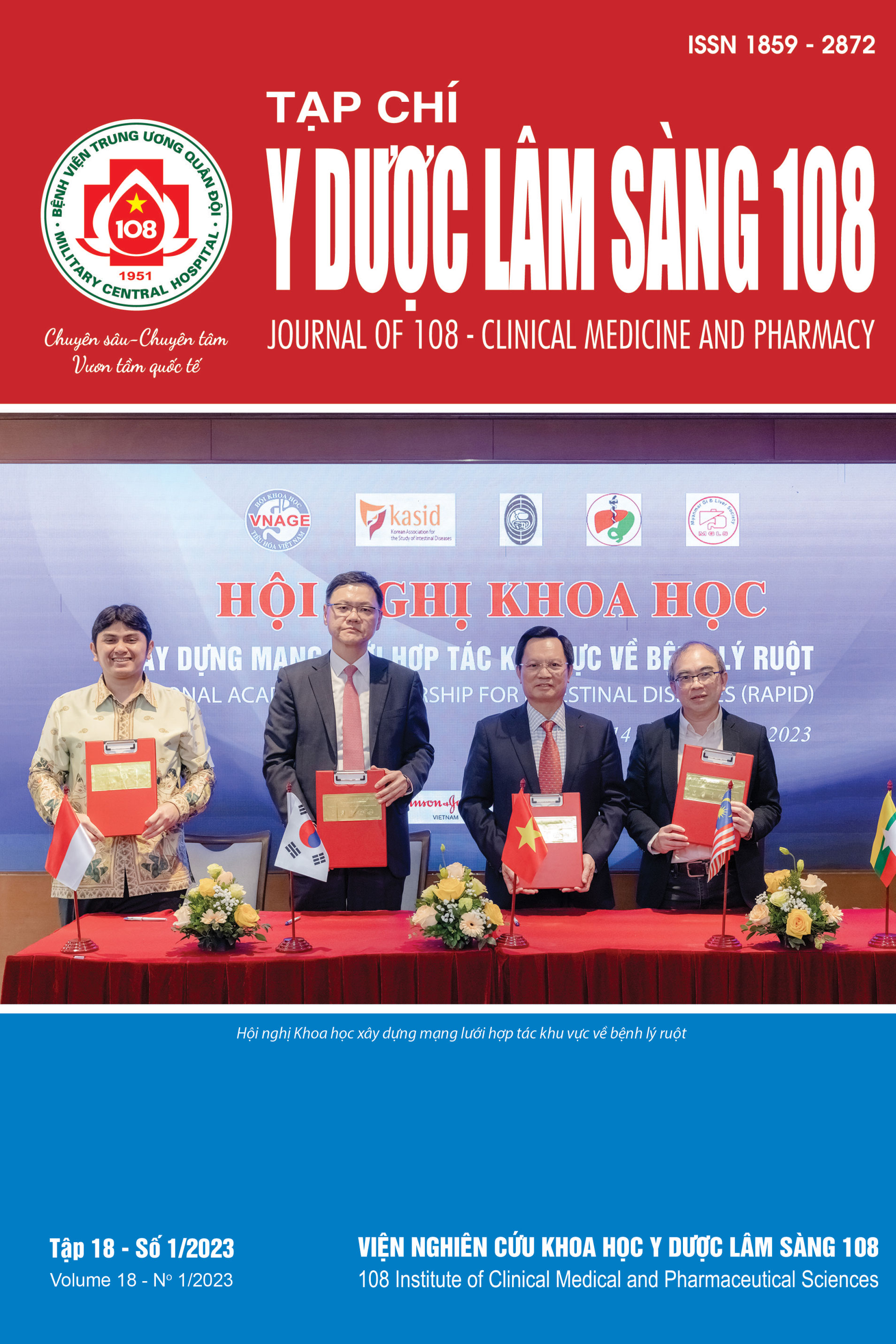Application results of diffusion-weighted magnetic resonance imaging in the diagnosis of cerebral infarction
Main Article Content
Keywords
Abstract
Objective: To evaluate the application of the diffusion-weighted magnetic resonance imaging in the diagnosis of cerebral infarction. Subject and method: A retrospective, cross-sectional descriptive study was carried out on 61 patients with cerebral infarction who underwent a magnetic resonance imaging (MRI) of brain and cerebral vessels with diffusion weighted imaging sequences at Hanoi Medical University Hospital. Result: Mean age was 66.3 ± 10.7, the lowest was 43, the highest was 91-year-old. Male/female ratio was 1.8/1. The mean time from onset to MRI was 23.1 ± 22.9 hours. MRI scan between 6-24 hours accounted for 45.9%. Supratentorial infarctus was 88.5%. The mean volume of cerebral infarction was 21.2 ± 40.2cm3. The detection rate of infarctus volume ≤ 1cm3 was 85.7%, over 1cm3 was 100%. The high-intensity signal rate on DWI before 6 hours, from 6-24 hours, after 24 hours and overall rate were 90.9%, 96.4%, 100% and 96.7%, respectively. Before 6 hours, the detection rate of cerebral infarction on T1WI and T2WI were 36.4% and 39.3%, respectively. The detection rate of cerebral infarction on FLAIR imaging before 6 hours, from 6-24 hours and after 24 hours were 54.5%, 89.3% and 81.2%, respectively. The vascular abnormalites on TOF was 52.5%. The DWI sensitivity on cerebral infarction detection in overall, before 6 hours and after 24 hours were 96.7%, 90.9% and 100%, respectively. Conclusion: DWI sequence had the highest value in the cerebral infarctus diagnosis, compared to other MRI sequences, especially in the hyper-acute stroke (before 6 hours). Therefore, we could recommend that the patient with acute stroke should be underwent early DWI.
Article Details
References
2. Nguyễn Duy Trinh và cộng sự (2014) Nghiên cứu đặc điểm hình ảnh cộng hưởng từ 1,5Tesla và giá trị các chuỗi xung khuếch tán và tưới máu trong chẩn đoán nhồi máu não cấp. Tạp chí Y học thực hành, tr. 60-64.
3. Mai DT và cộng sự (2012) Đánh giá hiệu quả điều trị đột quỵ nhồi máu não cấp trong vòng 3 giờ đầu bằng thuốc tiêu huyết khối đường tĩnh mạch alteplase. Luận án tiến sĩ Y học, trường Đại học Y Hà Nội.
4. Schellinger P, Thomalla G, Fiehler J et al (2007) MRI-based and CT-based thrombolytic therapy in acute stroke within and beyond established time windows an analysis of 1210 patients. Stroke J Cereb Circ 38: 2640-2645. doi: 10.1161 /STROKEAHA.107.483255.
5. Yoo DR, Im CB, Jun BG et al (2021) Clinical outcomes of endoscopic removal of foreign bodies from the upper gastrointestinal tract. BMC Gastroenterol 21(1): 385. doi: 10.1186/s12876-021-01959-3.
6. Schaefer PW, Barak ER, Kamalian S et al (2008) Quantitative assessment of core/penumbra mismatch in acute stroke: CT and MR perfusion imaging are strongly correlated when sufficient brain volume is imaged. Stroke 39(11): 2986-2992. doi:10.1161/STROKEAHA.107.513358.
7. Nguyễn VL, Võ TTH, Lê QK, Nguyễn TPL, Phan CC, Phạm NH (2020) Khảo sát đặc điểm của nhồi máu não cấp trên cộng hưởng từ thường qui và chụp mạch máu bằng kỹ thuật TOF 3D. Tạp chí Điện Quang học Hạt nhân Việt Nam. 2020;(40):80-86. doi:10.55046/vjrnm.40.205.2020.
8. Simonsen CZ, Madsen MH, Schmitz ML, Mikkelsen IK, Fisher M, Andersen G (2015) Sensitivity of diffusion- and perfusion-weighted imaging for diagnosing acute ischemic stroke is 97.5%. Stroke. 46(1): 98-101. doi:10.1161/STROKEAHA.114.007107
 ISSN: 1859 - 2872
ISSN: 1859 - 2872
